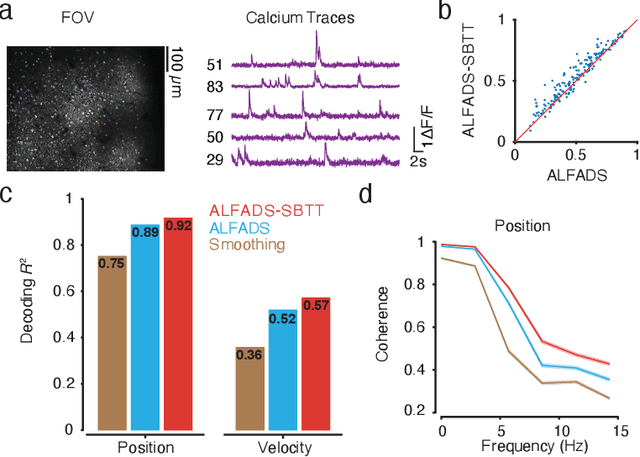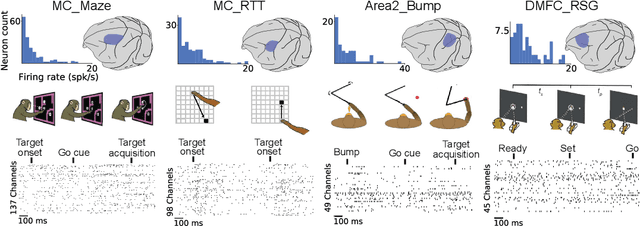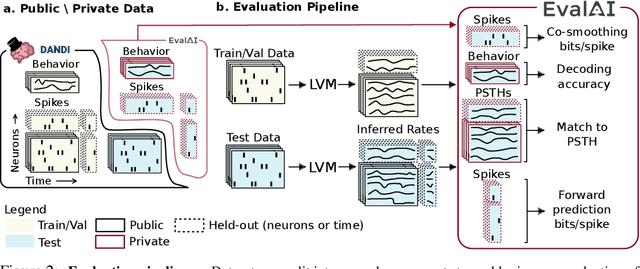Chethan Pandarinath
Diffusion-Based Generation of Neural Activity from Disentangled Latent Codes
Jul 30, 2024Abstract:Recent advances in recording technology have allowed neuroscientists to monitor activity from thousands of neurons simultaneously. Latent variable models are increasingly valuable for distilling these recordings into compact and interpretable representations. Here we propose a new approach to neural data analysis that leverages advances in conditional generative modeling to enable the unsupervised inference of disentangled behavioral variables from recorded neural activity. Our approach builds on InfoDiffusion, which augments diffusion models with a set of latent variables that capture important factors of variation in the data. We apply our model, called Generating Neural Observations Conditioned on Codes with High Information (GNOCCHI), to time series neural data and test its application to synthetic and biological recordings of neural activity during reaching. In comparison to a VAE-based sequential autoencoder, GNOCCHI learns higher-quality latent spaces that are more clearly structured and more disentangled with respect to key behavioral variables. These properties enable accurate generation of novel samples (unseen behavioral conditions) through simple linear traversal of the latent spaces produced by GNOCCHI. Our work demonstrates the potential of unsupervised, information-based models for the discovery of interpretable latent spaces from neural data, enabling researchers to generate high-quality samples from unseen conditions.
lfads-torch: A modular and extensible implementation of latent factor analysis via dynamical systems
Sep 03, 2023Abstract:Latent factor analysis via dynamical systems (LFADS) is an RNN-based variational sequential autoencoder that achieves state-of-the-art performance in denoising high-dimensional neural activity for downstream applications in science and engineering. Recently introduced variants and extensions continue to demonstrate the applicability of the architecture to a wide variety of problems in neuroscience. Since the development of the original implementation of LFADS, new technologies have emerged that use dynamic computation graphs, minimize boilerplate code, compose model configuration files, and simplify large-scale training. Building on these modern Python libraries, we introduce lfads-torch -- a new open-source implementation of LFADS that unifies existing variants and is designed to be easier to understand, configure, and extend. Documentation, source code, and issue tracking are available at https://github.com/arsedler9/lfads-torch .
Expressive architectures enhance interpretability of dynamics-based neural population models
Dec 07, 2022Abstract:Artificial neural networks that can recover latent dynamics from recorded neural activity may provide a powerful avenue for identifying and interpreting the dynamical motifs underlying biological computation. Given that neural variance alone does not uniquely determine a latent dynamical system, interpretable architectures should prioritize accurate and low-dimensional latent dynamics. In this work, we evaluated the performance of sequential autoencoders (SAEs) in recovering three latent chaotic attractors from simulated neural datasets. We found that SAEs with widely-used recurrent neural network (RNN)-based dynamics were unable to infer accurate rates at the true latent state dimensionality, and that larger RNNs relied upon dynamical features not present in the data. On the other hand, SAEs with neural ordinary differential equation (NODE)-based dynamics inferred accurate rates at the true latent state dimensionality, while also recovering latent trajectories and fixed point structure. We attribute this finding to the fact that NODEs allow use of multi-layer perceptrons (MLPs) of arbitrary capacity to model the vector field. Decoupling the expressivity of the dynamics model from its latent dimensionality enables NODEs to learn the requisite low-D dynamics where RNN cells fail. The suboptimal interpretability of widely-used RNN-based dynamics may motivate substitution for alternative architectures, such as NODE, that enable learning of accurate dynamics in low-dimensional latent spaces.
Deep inference of latent dynamics with spatio-temporal super-resolution using selective backpropagation through time
Oct 29, 2021



Abstract:Modern neural interfaces allow access to the activity of up to a million neurons within brain circuits. However, bandwidth limits often create a trade-off between greater spatial sampling (more channels or pixels) and the temporal frequency of sampling. Here we demonstrate that it is possible to obtain spatio-temporal super-resolution in neuronal time series by exploiting relationships among neurons, embedded in latent low-dimensional population dynamics. Our novel neural network training strategy, selective backpropagation through time (SBTT), enables learning of deep generative models of latent dynamics from data in which the set of observed variables changes at each time step. The resulting models are able to infer activity for missing samples by combining observations with learned latent dynamics. We test SBTT applied to sequential autoencoders and demonstrate more efficient and higher-fidelity characterization of neural population dynamics in electrophysiological and calcium imaging data. In electrophysiology, SBTT enables accurate inference of neuronal population dynamics with lower interface bandwidths, providing an avenue to significant power savings for implanted neuroelectronic interfaces. In applications to two-photon calcium imaging, SBTT accurately uncovers high-frequency temporal structure underlying neural population activity, substantially outperforming the current state-of-the-art. Finally, we demonstrate that performance could be further improved by using limited, high-bandwidth sampling to pretrain dynamics models, and then using SBTT to adapt these models for sparsely-sampled data.
Neural Latents Benchmark '21: Evaluating latent variable models of neural population activity
Sep 10, 2021



Abstract:Advances in neural recording present increasing opportunities to study neural activity in unprecedented detail. Latent variable models (LVMs) are promising tools for analyzing this rich activity across diverse neural systems and behaviors, as LVMs do not depend on known relationships between the activity and external experimental variables. However, progress in latent variable modeling is currently impeded by a lack of standardization, resulting in methods being developed and compared in an ad hoc manner. To coordinate these modeling efforts, we introduce a benchmark suite for latent variable modeling of neural population activity. We curate four datasets of neural spiking activity from cognitive, sensory, and motor areas to promote models that apply to the wide variety of activity seen across these areas. We identify unsupervised evaluation as a common framework for evaluating models across datasets, and apply several baselines that demonstrate benchmark diversity. We release this benchmark through EvalAI. http://neurallatents.github.io
Representation learning for neural population activity with Neural Data Transformers
Aug 02, 2021Abstract:Neural population activity is theorized to reflect an underlying dynamical structure. This structure can be accurately captured using state space models with explicit dynamics, such as those based on recurrent neural networks (RNNs). However, using recurrence to explicitly model dynamics necessitates sequential processing of data, slowing real-time applications such as brain-computer interfaces. Here we introduce the Neural Data Transformer (NDT), a non-recurrent alternative. We test the NDT's ability to capture autonomous dynamical systems by applying it to synthetic datasets with known dynamics and data from monkey motor cortex during a reaching task well-modeled by RNNs. The NDT models these datasets as well as state-of-the-art recurrent models. Further, its non-recurrence enables 3.9ms inference, well within the loop time of real-time applications and more than 6 times faster than recurrent baselines on the monkey reaching dataset. These results suggest that an explicit dynamics model is not necessary to model autonomous neural population dynamics. Code: https://github.com/snel-repo/neural-data-transformers
Enabling hyperparameter optimization in sequential autoencoders for spiking neural data
Aug 22, 2019



Abstract:Continuing advances in neural interfaces have enabled simultaneous monitoring of spiking activity from hundreds to thousands of neurons. To interpret these large-scale data, several methods have been proposed to infer latent dynamic structure from high-dimensional datasets. One recent line of work uses recurrent neural networks in a sequential autoencoder (SAE) framework to uncover dynamics. SAEs are an appealing option for modeling nonlinear dynamical systems, and enable a precise link between neural activity and behavior on a single-trial basis. However, the very large parameter count and complexity of SAEs relative to other models has caused concern that SAEs may only perform well on very large training sets. We hypothesized that with a method to systematically optimize hyperparameters (HPs), SAEs might perform well even in cases of limited training data. Such a breakthrough would greatly extend their applicability. However, we find that SAEs applied to spiking neural data are prone to a particular form of overfitting that cannot be detected using standard validation metrics, which prevents standard HP searches. We develop and test two potential solutions: an alternate validation method ("sample validation") and a novel regularization method ("coordinated dropout"). These innovations prevent overfitting quite effectively, and allow us to test whether SAEs can achieve good performance on limited data through large-scale HP optimization. When applied to data from motor cortex recorded while monkeys made reaches in various directions, large-scale HP optimization allowed SAEs to better maintain performance for small dataset sizes. Our results should greatly extend the applicability of SAEs in extracting latent dynamics from sparse, multidimensional data, such as neural population spiking activity.
LFADS - Latent Factor Analysis via Dynamical Systems
Aug 22, 2016



Abstract:Neuroscience is experiencing a data revolution in which many hundreds or thousands of neurons are recorded simultaneously. Currently, there is little consensus on how such data should be analyzed. Here we introduce LFADS (Latent Factor Analysis via Dynamical Systems), a method to infer latent dynamics from simultaneously recorded, single-trial, high-dimensional neural spiking data. LFADS is a sequential model based on a variational auto-encoder. By making a dynamical systems hypothesis regarding the generation of the observed data, LFADS reduces observed spiking to a set of low-dimensional temporal factors, per-trial initial conditions, and inferred inputs. We compare LFADS to existing methods on synthetic data and show that it significantly out-performs them in inferring neural firing rates and latent dynamics.
 Add to Chrome
Add to Chrome Add to Firefox
Add to Firefox Add to Edge
Add to Edge